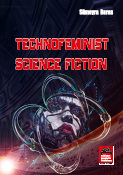TechnoFeminist Science Fiction
TechnoFeminist Science Fiction
Author(s): Sümeyra Buran
Subject(s): Politics / Political Sciences, Social Sciences, Economy, Gender Studies, Fine Arts / Performing Arts, Political Theory, Sociology, Social Theory, ICT Information and Communications Technologies
Published by: Addleton Academic Publishers
Keywords: TechnoFeminist Science Fiction; cyberfeminism; cyborg feminism; sociotechnical network; politics; technofeminism; Donna Haraway; science fiction;
Summary/Abstract: This study has coined the term TechnoFeminist Science Fiction by grounding it on the insights of Judy Wajcman’s TechnoFeminist approach that combines cyberfeminism and cyborg feminism following the philosophies of Sadie Plant and Donna Haraway. The core study of TechnoFeminism gives voice to the mutual relationship between women and technology that is a constructivist and a sociotechnical network by rejecting technological determinism. Likewise, TechnoFeminist Science Fiction, a new trend in women or feminist science fiction, provides both technoscientific politics and TechnoFeminist politics in desire for women or feminist science fiction writers to be more active in creating female cyber and cyborg images in their technoscience fictions. Thus, it aims to create new women perspectives and point of views by erasing the gender duality problem with characterization of emancipatory cyberself and cyborg embodiment through breaking down the boundaries between human and machine, animal/organism and machine, and physical and non-physical organisms. The aim of this study is to demonstrate how British novelists, Justina Robson and Sue Thomas, have opened a different technodigital space for equal and mutual relationship between gender and technology by weaving the issues of TechnoFeminism and the concepts of technoscience, AIs, genetic technologies, the internet, regenerative technologies, communication technologies, nanotechnology, biotechnology, molecular biology and they have also developed an image of the cyborg consistent with any of Haraway’s cyborg metaphors and cyberspace consistent with Plant’s cyberfeminism with wired, wet, fluid, flexible, adaptable, mutable, multiple, ever-flowing, unstable, self-controlled, virtual cyberselves.
- Print-ISBN-13: 978-1-935494-76-8
- Page Count: 308
- Publication Year: 2014
- Language: English
- eBook-PDF
- Table of Content
- Introduction
- Sample-PDF

